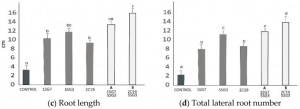A group from Agricultural University of Athens, Athens, Greece, etc. has reported that the mixtures of Bacillus (1.SG.7, 5.SG.3) and Pseudomonas (2.SG.20, 2.C.19) strains in wheat rhizosphere enhanced the lateral roots abundance and shoots biomass of wheat, and mitigated salinity stress, comparing with the cases used independently.
https://www.ncbi.nlm.nih.gov/pmc/articles/PMC8400701/
Sixty-eight arylsulfatase (ARS)-producing bacterias were isolated from the rhizosphere of durum wheat on calcareous soil. Phylogenetic analysis showed that most of the isolates belonged to the Pseudomonas and Bacillus genus. From view points of the following items, IAA production, antifungal activity, biofilm formation, and salinity tolerance, Bacterial Strains were selected from the isolated ARS-producing bacterias. Those were Bacillus (1.SG.7, 5.SG.3), Pseudomonas (2.SG.20, 2.C.19, 3.SG.19, 2.C.23, 4.SG.6, 2.SG.8)
All 8 bacterial strains enhanced the number of lateral roots and shoot biomass. The growth-promoting ability was enhanced by using strain mixtures, above all, mixtures of Bacillus (1.SG.7, 5.SG.3) and Pseudomonas (2.SG.20, 2.C.19) strains, enhanced the lateral roots abundance and shoots biomass, mitigated salinity stress.
Since the rhizosphere is a quite complex system including a number of bacterias and fungi, it must be a good way to focus on representative strains as shown here to understand how more effective rhizospheric consortium is formed as plant growth promoting rhizobacteria (PGPR).


